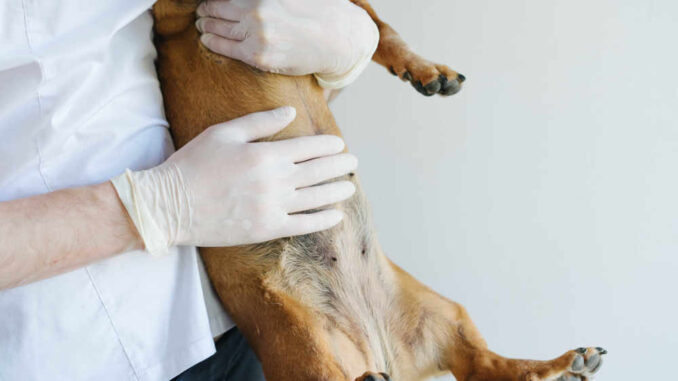
This article was updated on February 16th, 2024

You’re giving your dog belly rubs when you notice a new scab on their nipple. You aren’t sure what happened and are looking for some guidance on what could be going on. In this article, our veterinarians Dr. Sarah Graves and Dr. Jamie Whittenburg explain when nipple scabs are a cause for concern, and what you should know:
1. Mild black spots or scabs on nipples are likely not a reason for concern
In the picture below, mild discoloration of the nipple is usually not a cause for concern unless your dog is showing other signs of discomfort. This is likely due to benign dirt/sebum or hyperpigmentation (darkening of a dog’s skin or fur due to an excess of pigment.)
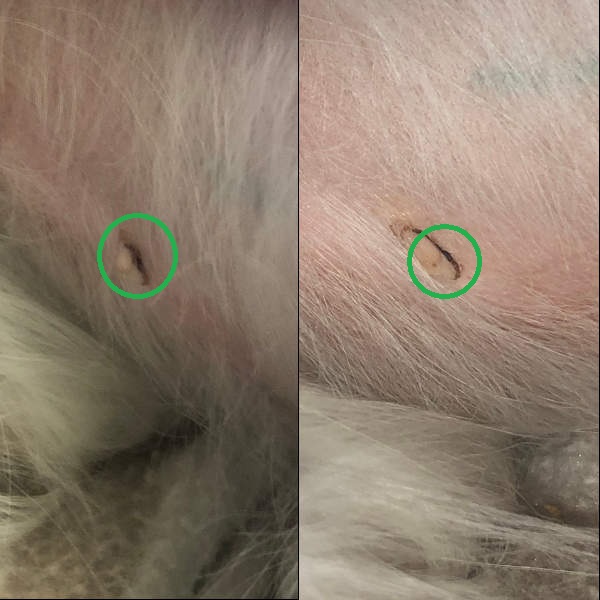
2. Scabs on nipples are a reason for concern when you see these symptoms
When examining scabs on your dog, it’s important to determine if they are flat or raised and if your dog is itchy or uncomfortable. In the picture below, we can see some dark brown spots on the skin around the nipples:
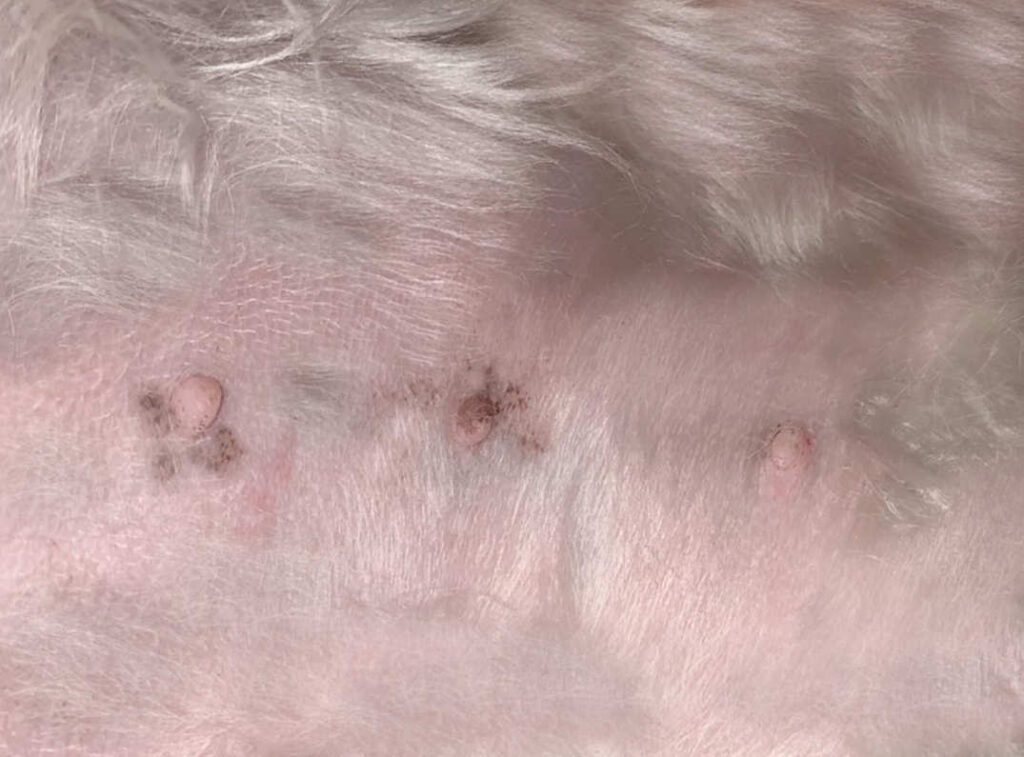
- If flat, this could be benign hyperpigmentation, or darker skin that occurs with aging (age spots).
- If raised or accompanied by other symptoms such as itchiness or skin irritation, we’d be wondering about a more serious cause such as a skin infection or allergic skin disease.
If these new spots or scabs suddenly appear on your dog’s nipples, a vet check is wise and your vet may run some tests such as a skin swab or blood tests (if considering hormonal disease). It may be that your dog needs a medicated wash.
The picture below shows an example of scabs that are caused by an underlying medical issue (in this case a skin infection). The scabs are raised, with skin redness and irritation:
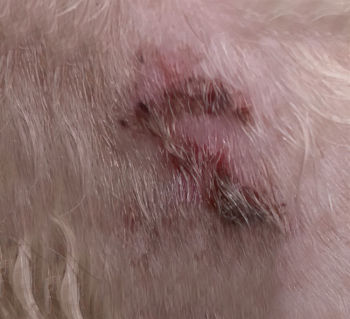
However, keep in mind that this picture above is just one example. Scabs can take many shapes and forms. Dr. Whittenburg explains the signs that you need to see your vet:
You should see your veterinarian if you see any of these symptoms:
– Scabs persist for more than a few days: this may indicate an underlying skin condition or infection.
– Your dog is scratching or licking their nipple scabs, as this can make the issue worse.
– Scabs change color or size.
– A discharge is seen along with the scabs.
– The dog’s skin also appears red, irritated or flaky.
3. Common causes of scabs on nipples
“The most common reasons for a scab on your dog’s nipples are allergies and skin infections. Both can irritate the skin and result in scabs in sensitive areas like the nipples. Scabs could also be due to a self-inflicted injury – for example when your dog is excessively scratching or licking the area – or other medical conditions like cancer.”
Here are the most likely reasons:
1. Allergies
While there are various causes for your dog’s allergies, they usually result in similar signs: extreme itchiness, inflamed skin, crusts, and scabs. Excessive itchiness can lead to scratching other body parts, like the abdomen, causing inflammation of the skin and nipples.
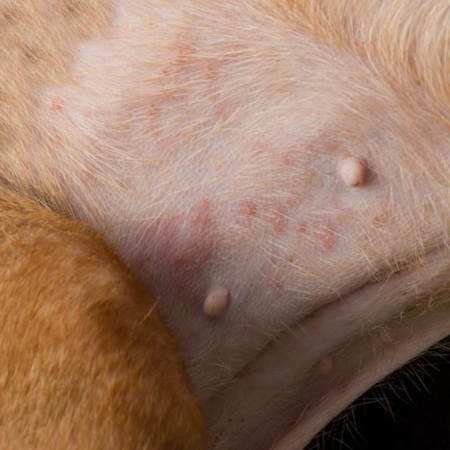

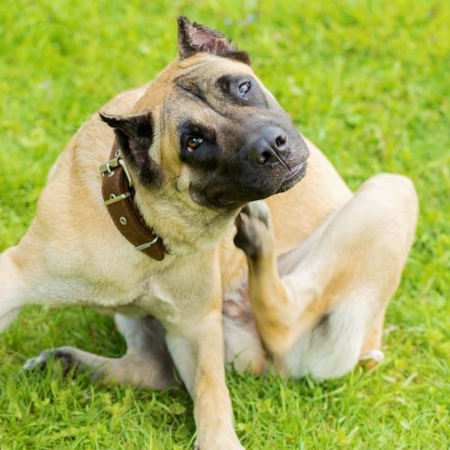
Flea allergies, food allergies, and environmental allergies can all cause your dog to itch excessively and have red, inflamed skin and scabs. If your dog has nipple scabs and is itchy (frequently scratching, licking, rubbing or chewing), read our page about Skin Issues due to Allergies.
2. Bacterial Infections
Bacterial infections are common issues in both dogs and humans. Since, in rare cases, ‘staphylococcus’ infections can be transmitted between humans and dogs, it is critical to recognize symptoms and promptly treat them.
Bacterial infections typically cause skin irritation, redness, and bumps called pustules, which look like small pimples (see picture below). When dogs scratch, the infected area may burst open, leaving pus and sores that crust over and form scabs. Your dog may be itchy from these infections, too.
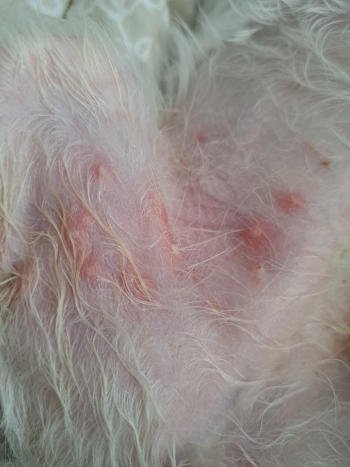
Other symptoms include 1) pain, 2) red or inflamed skin, 3) excessive licking or itching, 4) patchy fur.
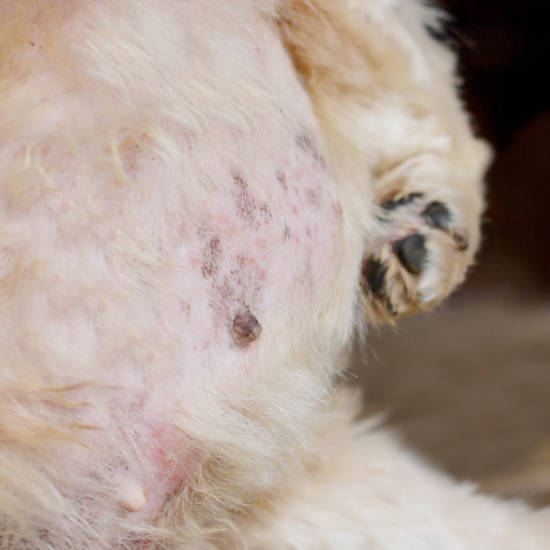
To diagnose a bacterial infection, your vet might perform diagnostic tests like a tape impression or skin scrape. In these tests, they take samples of the superficial layers of the skin to look at under the microscope and possibly identify bacteria. Most of the time, bacterial infections are treated with antibiotics.
Learn more: Bacterial Infections (Pictures, Symptoms, Treatments).
3. Fungal Infections / Yeast Infections
A nipple scab can indicate a fungal infection. The difference between fungal and bacterial infections is the source. Fungi (yeast) cause fungal infections and examples include Aspergillus and Dermatophytosis (ringworm).
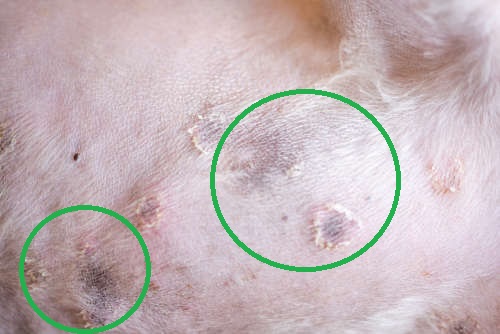
Your dog can have a local fungal infection, which is also called a yeast infection. Dr. Graves says:
“Yeast infections thrive in moist areas and can quickly get into tiny crevices in the ears or skin folds around the nipples. These infections are often itchy; your dog may scratch one spot constantly. Since the skin is the first barrier against disease, micro-cuts from itching increase the likelihood of developing an infection, forming scabs from the moist discharge.”
Other symptoms include 1) redness, 2) discharge or moist wounds, 3) musty or “stale corn chip” smell, 4) crusts and scabs.
Your vet will determine whether your dog has a fungal infection based on a fungal culture test. It is important to determine if the problem is bacterial or fungal, because fungal infections will not respond to antibiotics. Learn more: Fungal Infections (Pictures & Treatments).
If you don’t treat a skin infection on your dog, it can get worse and spread. This might lead to more severe infections and ongoing issues. Without veterinary care, the infection could cause discomfort and even make your dog seriously ill. It’s important to see your vet as soon as you see signs of skin infections. Learn more about Skin Infections in Dogs.
4. Self-inflicted Injury
Your dog may have scabs on its nipples from play or other activities. If you notice scabs on your dog but don’t see any other symptoms, this would be the most likely scenario. You shouldn’t worry if it looks like it’s healing well.
5. Nursing
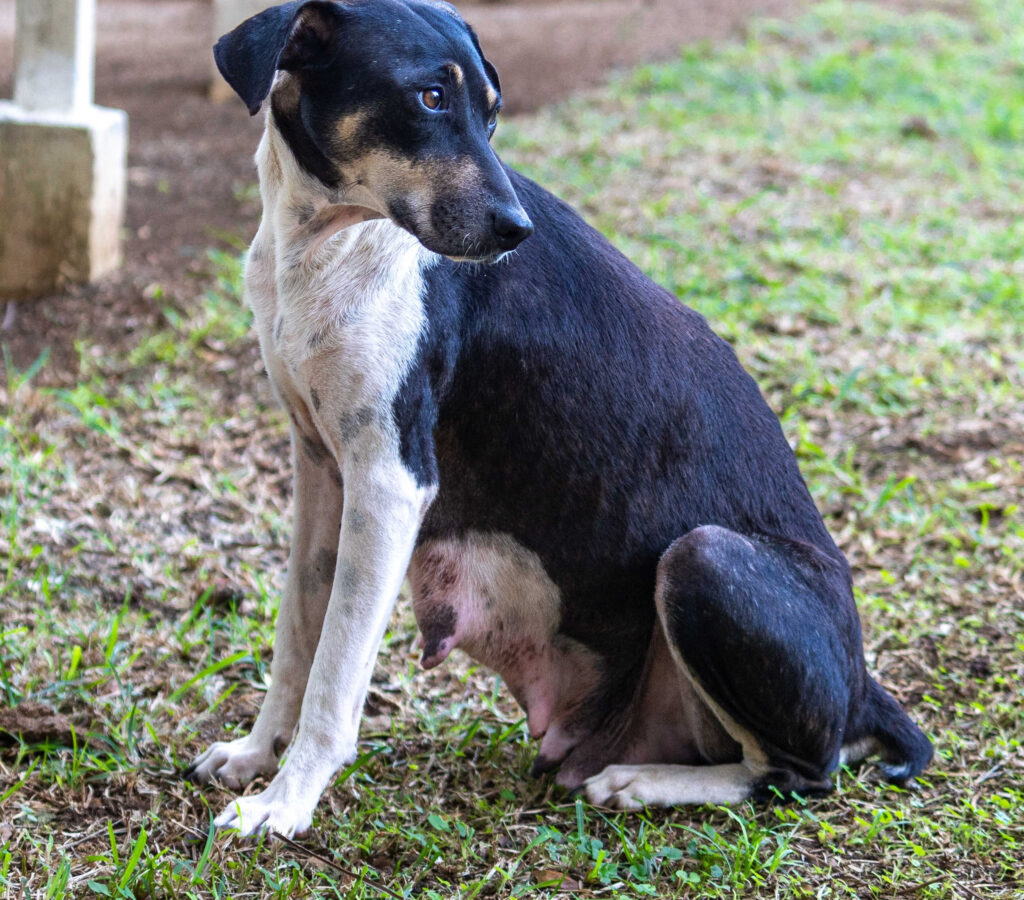
A nursing dog constantly has sharp little teeth biting or sucking on her teets, which can cause irritation and broken skin. Nursing mothers are more likely to have scabs on their nipples because of this.
Injured nipples allow bacteria to enter the breast canal and can lead to infection, causing a painful condition called mastitis. To prevent mastitis, ensure your dog’s nipples are being used for feeding equally. Overused nipples can be sore and irritated.
If the nipples are already irritated, apply a warm compress to ease some discomfort. Some evidence shows cabbage leaves over the mammary glands can help with mastitis. Don’t apply lotion or ointment to the area unless prescribed by your veterinarian since they may affect nursing puppies. Learn more about Mastitis.
6. Inverted Nipples
Inverted nipples aren’t usually an issue for a dog, and they rarely cause any discomfort. However, they are slightly more likely to lead to infections, though. This is because sebum, the natural skin lubricant, builds up around the inverted nipple. Additionally, the abnormal structure makes infection or trauma (like from nursing) more likely.
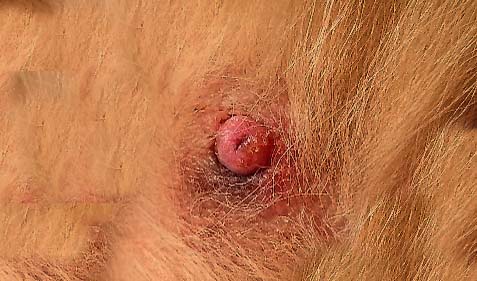
Inverted nipples can cause issues due to the accumulation of sebum. Symptoms of an issue include:
- Inflammation, redness
- Swelling
- Color change
They can also be an issue if your dog is nursing, as it can be challenging for the puppies to feed appropriately.
If your dog has inverted nipples, you need to properly clean them once or twice a month (see FAQ below for more information on cleaning).
7. Cancer
One of the most prominent signs of skin cancer in a dog is a scab that doesn’t heal or presents strange qualities. Scabs may not heal because cancer can suppress the immune system. There are different types of cancers which can show up differently on the skin and nipples:
- Mammary tumors can be benign or malignant. Many start off as rubbery or hard lumps under the skin. Over time, the lumps grow and this can lead to scabs, skin ulceration and infections. See pictures of mammary tumors.
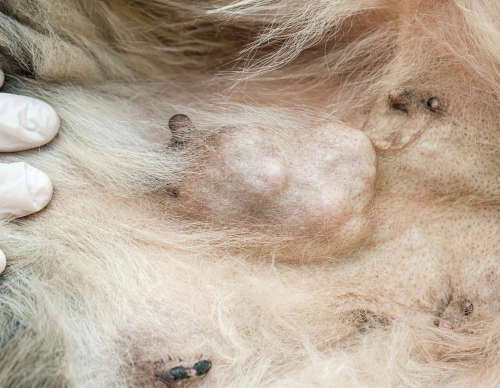
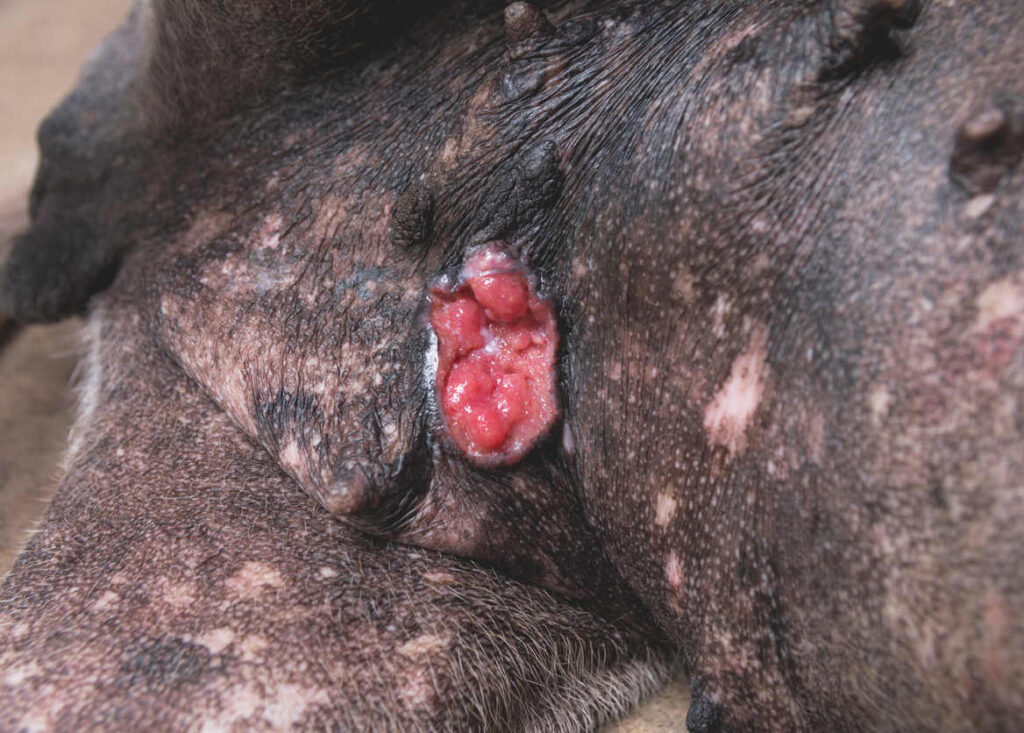
- Mast cell tumors can show up as small rubber-like inflamed sores. See pictures of mast cell tumors.
- Melanomas often present as dark/black lumps or bumps in areas exposed to the sun. See pictures of melanomas.
- Squamous cell carcinomas can seem like raised wart-like blemishes.
It’s easy to miss these or dismiss them as flea bites or other mild issues in the early stages. Dr. Graves advises:
“Certain cancers can affect the mammary tissue and the nipples. If you notice any discharge, blood, abnormal swelling, or masses, have your dog examined by a vet. Mammary cancer often causes firm swellings under the skin, leading to ulcerations and scab formation.”
The best outcome for cancer comes from early treatment, which is why you need to be vigilant.
Vets will diagnose cancer by examining the cells of the lump or bump. Fine needle aspiration uses a small needle to get a few cells for review under the microscope. This can sometimes help determine if a mass is concerning or cancerous.
Every cancer is different, which makes it impossible to know what treatment your vet will recommend. Some will be removed surgically, but others require radiation or chemotherapy.
FAQ
Are my dog’s nipples infected?
It’s hard to determine whether your dog’s nipples are infected. A scab alone does not singularly mean there is an infection.
Symptoms of infection include:
- Localised swelling, redness, heat, ooze, crusting and/or tenderness
- Fever
- Lethargy
- Food refusal
- Panting
- Ulceration of the skin or abscesses, when the infection is severe
Tips for cleaning your dog’s nipples
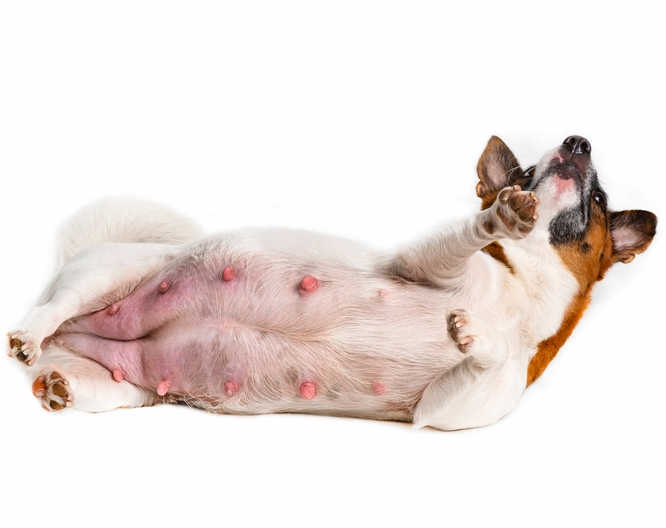
While the dirt may not be removed with a belly rub, there are ways to get rid of it. The best method is to use a dog-safe cleanser or light oil. Something like salt water and dilute Chlorhexidine works well for skin cleaning. As well as cotton wool, Q tips can work well in this area.
What does a scab look like on a dog’s nipples?
When your pet is scraped or bitten, special blood cells called platelets travel to the site. They perform a vital role in clot formation; this clot formation helps stop bleeding. Over time, the blood clot hardens into a scab through exposure to the open air. The tissue underneath will regenerate, causing the scab to grow smaller as the new skin takes over. Scabs come in many different shapes and sizes.
Disclaimer: This website's content is not a substitute for veterinary care. Always consult with your veterinarian for healthcare decisions. Read More.




My mix bread German Shepard husky is almost 2 years old and has scabs on all her nipples I has just noticed I just looking to see if anyone can give me any information before I contact a vet